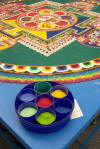The exiled
Tibetan Lamas visiting Maui this past week (Jan. '03) from
Tashi Lhunpo
Monastery in Bylakbpe, India
built a Sand Mandala. (click the thumbnails to see large
image)
During the closing ceremony, the monks dismantle the mandala, sweeping up the colored sands to symbolize the impermanence of all that exists. The mixed sand is distributed to the audience as blessings for personal health and healing and the balance is set adrift in the ocean. The Tibetan Culture is one of the most ancient of our planet and it is highly endangered as a result of the Chinese communist invasion of their homeland in the 1950's. Because of the wholesale destruction of their heritage there, and the genocidal Chinese policies during the Chinese colonization of Tibet, the Tibetans today live a fragile existence in the refugees camps of India. Our generation could be the last to see their artistic culture in its full richness, integrity and splendor.
|









